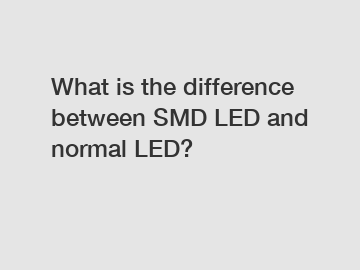What is the difference between SMD LED and normal LED?
What is the difference between SMD LED and normal LED?
LED, short for Light Emitting Diode, has become a popular lighting solution in various industries due to its energy efficiency and long lifespan. As LED technology advances, different types of LEDs have emerged to fulfill specific requirements. Two commonly used types of LEDs are Surface Mount Device (SMD) LEDs and normal LEDs. In this article, we will explore the differences between these two types and understand their applications.
Definition and Structure.

Normal LEDs, also known as through-hole LEDs, are the traditional type of LED that have been in use for decades. These LEDs consist of a semiconductor chip placed in a reflective cup, which is then encased in a transparent or colored epoxy resin. The leads, known as anodes and cathodes, protrude from the bottom of the epoxy resin for soldering onto a printed circuit board (PCB).
On the other hand, SMD LEDs are a newer generation of LEDs that are smaller and more versatile than normal LEDs. SMD LEDs are called surface mount devices because they are mounted directly onto the surface of a PCB. They do not possess leads like normal LEDs but instead have small metallic contacts on the bottom. SMD LEDs are typically rectangular in shape and are available in various sizes, from 0402 (0.4mm x 0.2mm) to 5050 (5.0mm x 5.0mm).
Size and Flexibility.
One of the major differences between SMD LEDs and normal LEDs is their size. SMD LEDs are significantly smaller than normal LEDs, making them suitable for applications where space is limited. With their compact size, SMD LEDs can be used in thin panel displays, backlighting for LCD screens, and even in wearable devices. Normal LEDs, on the other hand, are bulkier and are often used in lighting fixtures, automotive lighting, and signage.
Brightness and Illumination.
Both SMD LEDs and normal LEDs are available in a wide range of brightness levels. However, SMD LEDs tend to offer higher brightness compared to normal LEDs due to advancements in technology. This makes SMD LEDs suitable for applications that require intense illumination, such as outdoor signage or high-definition displays. On the other hand, normal LEDs are commonly used for general lighting purposes, such as residential lighting and indicator lights.
Ease of Installation.
With their surface mount design, SMD LEDs are easier to install compared to normal LEDs. SMD LEDs can be soldered directly onto the PCB surface using specialized equipment, ensuring a secure connection. Normal LEDs, on the other hand, require the leads to be inserted through holes in the PCB, followed by soldering on the opposite side. This extra step makes the installation process more time-consuming and requires extra care to prevent damage to the leads.
Conclusion.
In summary, SMD LEDs and normal LEDs differ in terms of their structure, size, brightness, and installation methods. SMD LEDs offer a compact size, higher brightness, and easier installation, making them suitable for applications with limited space and high illumination requirements. On the other hand, normal LEDs are more commonly used in general lighting applications and automotive lighting. Understanding the differences between these two types of LEDs will help you choose the right lighting solution for your specific needs.
If you have any further questions about SMD LEDs or normal LEDs, please feel free to contact us. Our team of experts will be more than happy to assist you.
Are you interested in learning more about led dip smd cob, smd led lights, are smd led better? Contact us today to secure an expert consultation!

Comments
0